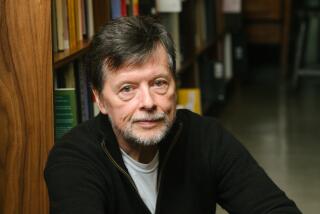The fate of mankind, linked to the horse
- Share via
“THIS is how horses help us. They embody the in-between, not only in between wandering and settling down but also in between the fenced and the free.” If there is a central theme to “Horse: How the Horse Has Shaped Civilizations” by J. Edward Chamberlin, it is the yin-and-yang nature of these seemingly opposite conditions. The theme is invoked frequently in the course of chapters on such topics as the horse in war and how horse travel changed the world.
However far the author may range, both in time (from Paleolithic cave paintings to present-day Olympic events) and place (from Iceland’s fiords to the Mongolian steppes), his view of the ultimate significance of the horse in the human experience can be summed up along these lines: They’ve served as a means for “people to roam from place to place like beasts of the field, to travel to foreign lands like flocks of migrating birds, and to build new cities and cultures. Horses, apparently, are agents of both ‘barbarism’ and ‘civilization.’ ”
Chamberlin reveals himself as a defender and even champion of many elements of the so-called “barbaric,” i.e. the nomadic life on horseback, whether the horseman be Genghis Khan or the Lone Ranger. He points to the wistful contradiction inherent in a song line every American schoolchild knows: “O give me a home, where the buffalo roam,” writing: “ ‘home’ and ‘roam’ ... their senses pull in completely opposite directions.”
Chamberlin’s background would appear to have guided him naturally to the subject of “Horse.” As a professor at the University of Toronto he has contributed greatly to what might be called the anthropology of literature, with a focus on nomadic or displaced cultures. (One of his previous titles is “If This Is Your Land, Where Are Your Stories?”) Indeed, “Horse” itself turns out to be highly minable for fascinating, little-known facts about migratory peoples. (Mongolia is the only part of our planet where horses outnumber humans. Among the herders of the Kalahari, the word used to start a story, garube, with a soft click made at the front of the mouth preceding the word’s pronunciation, means “the happening that is not happening.”) Chamberlin has also served with the Canadian Royal Commission on Aboriginal Peoples. On a more personal level, his grandfather lived with the Blackfoot -- a tribe with a deep horse culture -- in the 1880s, and Chamberlin himself has “been around horses a lot in my life. Mostly, I have stayed on the ground.”
This last detail -- more time on the ground than in the saddle -- may not have worked wholly to the book’s advantage. For all his assembled knowledge, both serendipitous and encyclopedic, the author’s voice remains that of an earth-bound observer. Page by page, Chamberlin strains to convey a sense of the horse as a creature hovering between heaven and Earth, something approaching a divine intervention in the human story. But his prose fails to infect and transport the way that, say, a poem on horses by John Muir does, or the recently published French memoir “Cavalier seul,” by amateur rider Jerome Garcin, or even the spare yet inspiring wisdom of Olympian George Morris’ book on riding, “Hunter Seat Equitation,” which is left oddly unmentioned in “Horse.”
Chamberlin’s general style too may present a few hurdles to some readers. One stumbles over some rather treacly anthropomorphisms (“A big gray mare, almost pure white by now, she knew the stories of the old, old days. She remembered one about a winter thousands of years before.... “), and an ambient affinity for alliteration. Intriguing categorical assertions may crop up as truisms, as in: “After wandering and settling down, [the conflict between naturalness and artifice] is the oldest argument in the history of humanity.” But the greatest frustration comes from an all-too-frequent sense of non sequitur -- brought on by the portentous statement that begs for connection, the train of thought that never quite arrives.
That said, “Horse” has much to offer, whether as a welcome addition to the insatiable horse-person’s library (we need the right books to tide us over whenever we or our favorite ungulate is temporarily laid up) or, somewhat in the tradition of Jared Diamond’s immensely popular “Guns, Germs and Steel,” to open an intriguing new perspective on the vagaries of technology and man’s fate. Well-chosen illustrations further enrich the pages. Both as a genuine labor of love and awe and as a treasure trove of equinalia, “Horse” is bound to find many delighted fans.
Kai Maristed is the author of the novels “Broken Ground,” “Out After Dark” and “Fall.”
More to Read
Sign up for our Book Club newsletter
Get the latest news, events and more from the Los Angeles Times Book Club, and help us get L.A. reading and talking.
You may occasionally receive promotional content from the Los Angeles Times.








